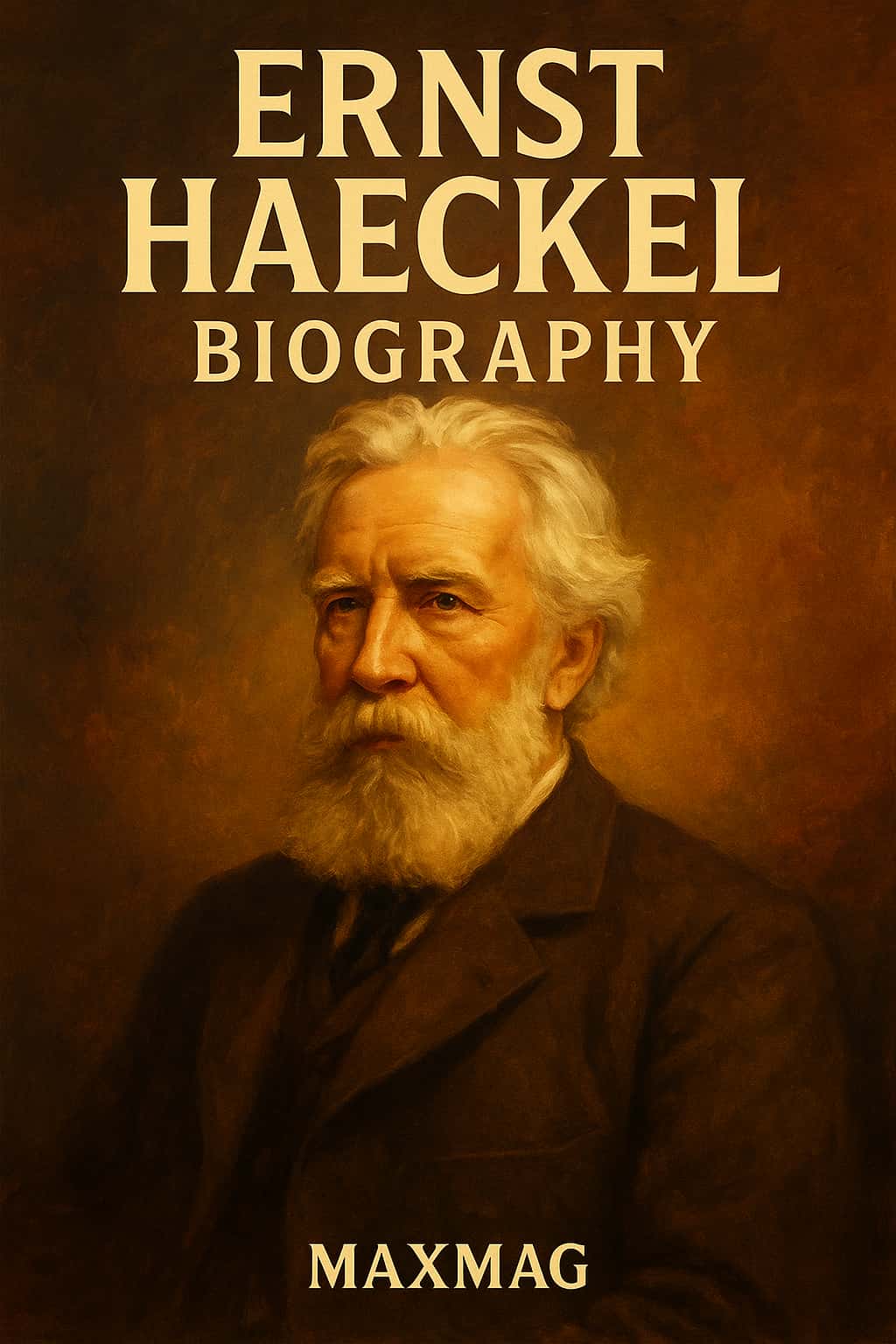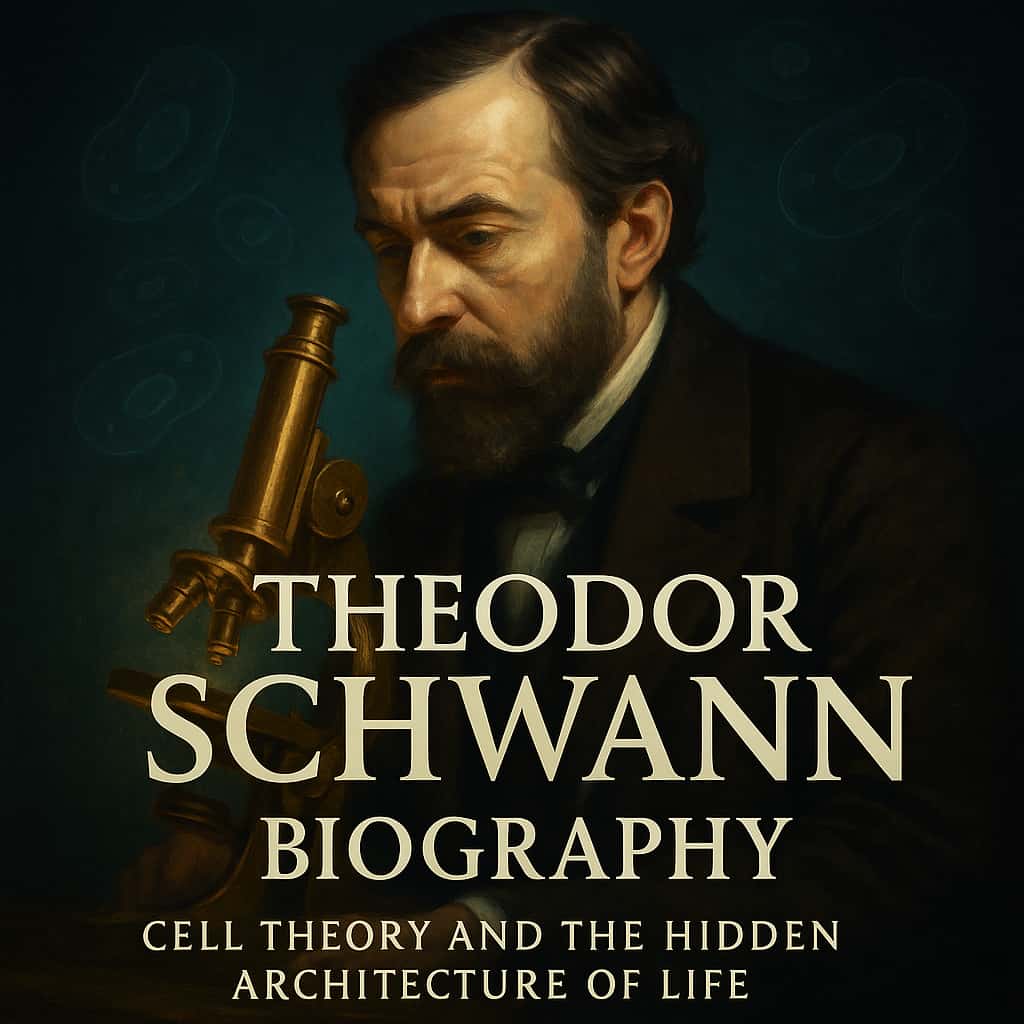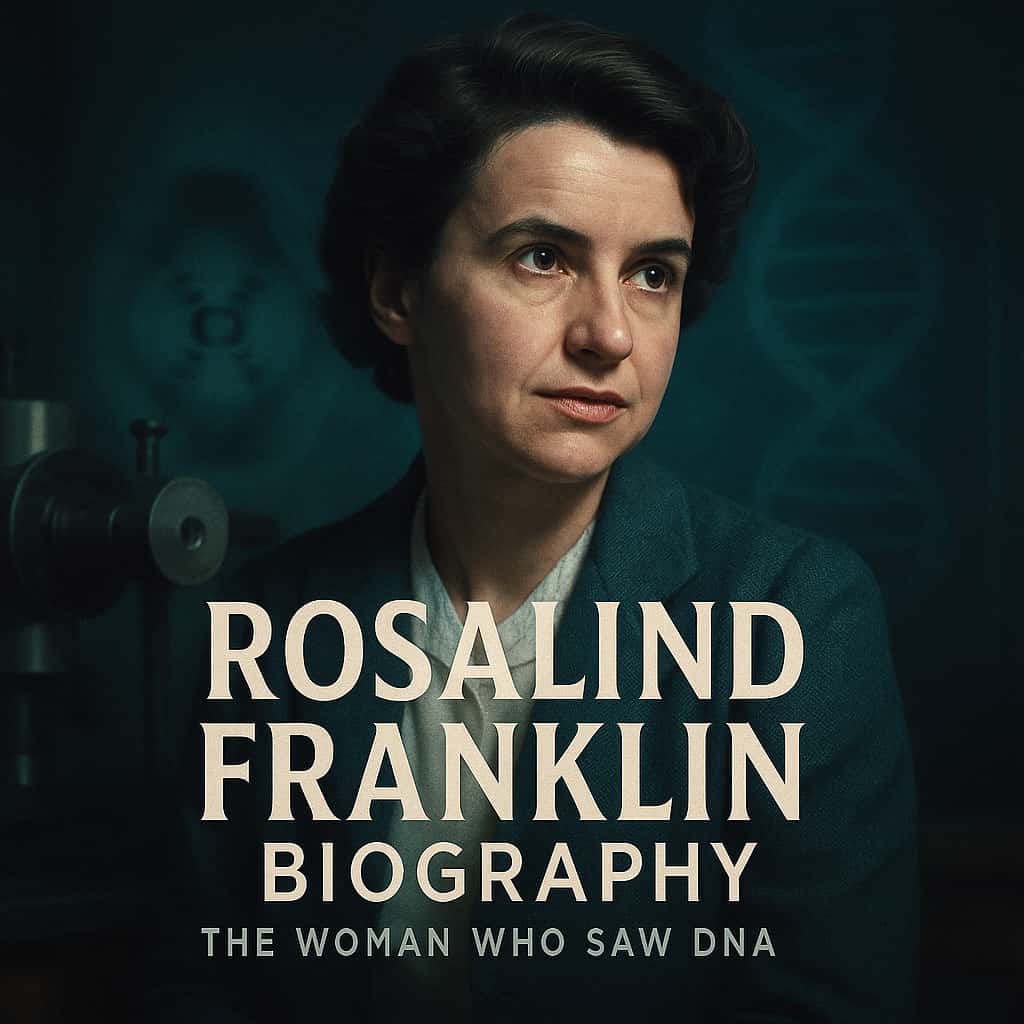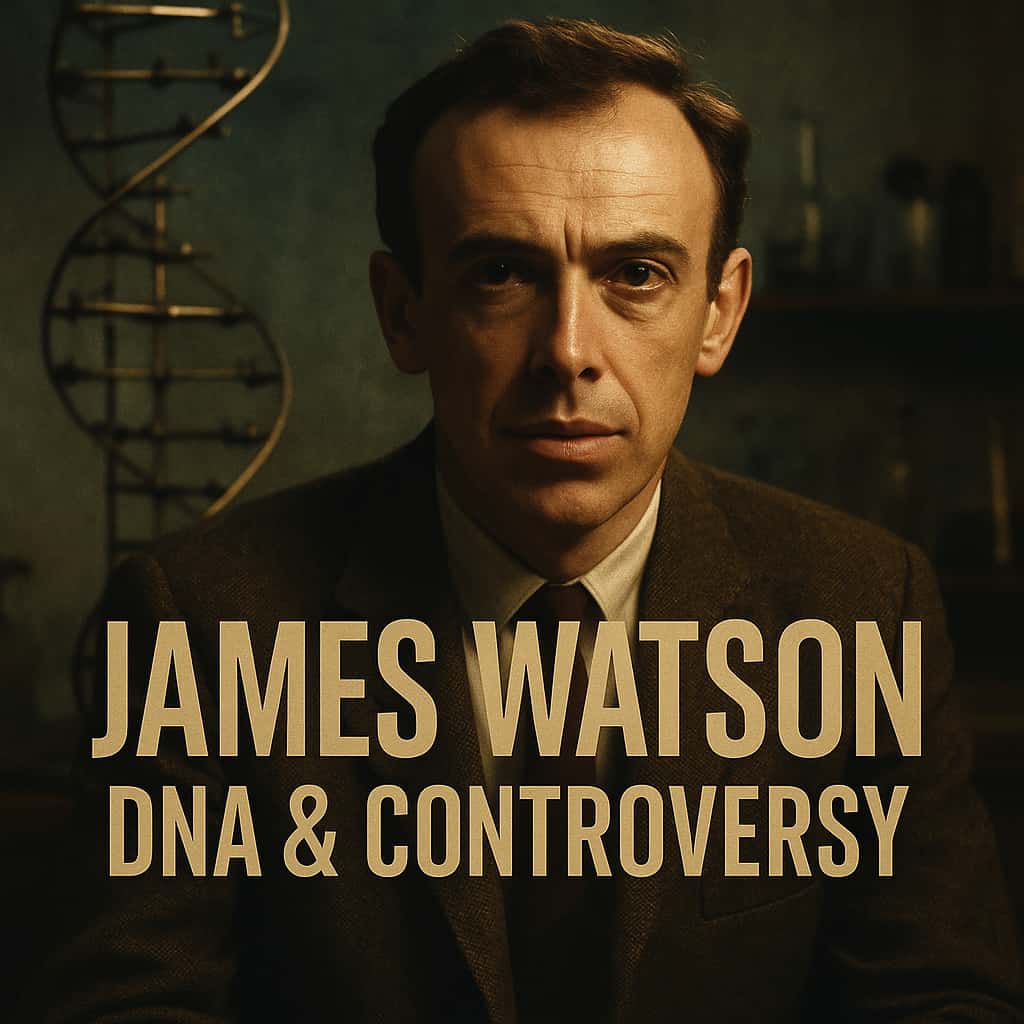
On a cold Cambridge morning in the early 1950s, a young American biologist strode into the Cavendish Laboratory carrying little more than boldness, gossip and a hunger to solve one of the greatest puzzles in science: the structure of DNA. That moment sits at the heart of any James Watson biography, because what he and Francis Crick eventually worked out – a double helix that looked like a twisted ladder – would change not only biology but how humanity understands itself.
Yet the James Watson biography is not a simple story of heroic discovery. It is the story of a boy genius from Chicago who entered university at 15, a molecular biology pioneer who shared a Nobel Prize, a combative institution-builder who helped launch the Human Genome Project – and an ageing scientist whose own words on race, intelligence and gender eventually stripped him of honours and left him a deeply divisive figure.
James Watson at a glance
- Who: James Dewey Watson (1928–2025), American molecular biologist and geneticist.
- Field and era: Mid–20th century science at the birth of molecular biology and modern genetics.
- Headline contribution: Co-discovery of DNA’s double helix structure and pioneer of molecular genetics education.
- Why he matters today: His work underpins genetic medicine, forensics and ancestry testing, but the James Watson biography also raises urgent questions about ethics, prejudice and power in science.
This James Watson biography traces how a restless young scholar became a central figure in 20th century science, how the DNA double helix was really cracked, why Rosalind Franklin’s role matters so profoundly, how molecular biology grew around his textbooks and institutions – and how his repeated racist and sexist remarks forced science to reckon with the character of its own heroes.
Early Life and Education of James Watson
Family roots behind the James Watson biography
James Dewey Watson was born in Chicago on 6 April 1928, the only son of a businessman, also named James, and Jean Mitchell, whose family mixed Scottish and Irish immigrant roots. Growing up on the city’s South Side, he was surrounded by books, birds and baseball, an unlikely combination that would later feed directly into the James Watson biography: he was both a scholarship child of the Great Depression and a product of midwestern ambition.
He was a precocious child, obsessed first not with DNA but with ornithology. He joined birdwatching clubs, memorised field guides and spent long hours identifying species along Lake Michigan. The discipline of watching closely – of learning to see patterns where others saw only flocks – foreshadowed the attention to detail that molecular genetics would demand from him later.
University of Chicago and the making of a molecular biology pioneer
At 15, Watson entered the University of Chicago under a special programme for gifted youngsters, an early sign of the speed that runs through any James Watson biography. He finished his degree astonishingly quickly, graduating in zoology in 1947. Those years exposed him to a “Great Books” curriculum that encouraged argument, scepticism and big ideas, and to the growing excitement around genetics that followed the rediscovery of Gregor Mendel’s work.
He stayed in the Midwest for his PhD, moving to Indiana University to study under Salvador Luria, one of the Italian founders of modern bacterial genetics. Luria’s lab was at the front line of the new “phage group” – scientists who used viruses that infect bacteria to probe how genes work. In this environment, Watson shifted from birds to molecules, absorbing a vision of biology in which heredity could be measured, mapped and, eventually, read.
By the time he completed his doctorate at just 22, Watson was already marked as a rising figure in the history of molecular genetics, shaped by mentors who believed that the deepest secrets of life were written in chemical code.

James Watson biography and the Birth of the Double Helix
The James Watson biography meets the double helix
After a short postdoctoral stay in Copenhagen, Watson arrived in Cambridge in 1951, joining the Cavendish Laboratory at the University of Cambridge. There he met Francis Crick, an older, equally talkative physicist-turned-biologist. The pair quickly realised that they shared a near-manic focus on one question: what did DNA actually look like in three dimensions? That obsession is the axis around which every James Watson biography turns.
DNA was already known to contain genes, but its shape remained mysterious. Some saw it as a long, featureless chain; others suspected a more elaborate structure. Watson and Crick approached the problem like puzzle-solvers, using bits of experimental data gathered by others and building physical models with metal plates and rods. Their style contrasted sharply with more cautious experimentalists: they guessed boldly, then checked whether the guesses could possibly be true.
Rosalind Franklin, X-ray patterns and a race in 20th century science
Crucial to their breakthrough were the X-ray diffraction images produced at King’s College London by Rosalind Franklin and her student Raymond Gosling. Those images, especially the famous “Photo 51”, showed a distinctive cross pattern indicating a helical structure with specific dimensions. Watson first saw an X-ray photograph in late 1951 and misinterpreted it; later, under controversial circumstances, he and Crick were shown Franklin’s more refined data without her explicit consent.
The ethical questions around how Franklin’s work was used have become a central thread in any modern James Watson biography. Franklin was not properly credited at the time, and she died in 1958, too early to share in the Nobel Prize. Today, historians of molecular biology emphasise that the DNA double helix was not the work of two men alone but the culmination of a broader, often competitive research community that included Franklin, Gosling and Maurice Wilkins, among others.
Model building and the Nature paper
In early 1953, armed with Franklin’s measurements and Chargaff’s rules about base pairing, Watson and Crick began to build their final model. They treated DNA like a construction set, trying out possible arrangements of sugar-phosphate backbones and chemical bases until everything clicked. The moment of insight, when the complementary base-pairing scheme snapped into place, has become scientific legend.
Their solution pictured DNA as two intertwined strands, running in opposite directions, with sugar-phosphate backbones on the outside and paired bases on the inside. It was elegant and, crucially, explained how genetic information could be copied: each strand could act as a template for its partner. Think of it as a zip that can be unfastened and re-zipped, each tooth (or base) matching only one partner tooth on the other side.
In April 1953 they published a short, almost modest paper in Nature, “A Structure for Deoxyribose Nucleic Acid”. Alongside it appeared companion papers from Wilkins’s group and from Franklin and Gosling, outlining the experimental evidence. The announcement barely made the newspapers, but within a decade the DNA double helix had become the central icon of molecular biology. For readers who want to dive deeper into how the helix works at a chemical level, the National Human Genome Research Institute provides a detailed DNA double helix fact sheet that explains its structure in accessible language.
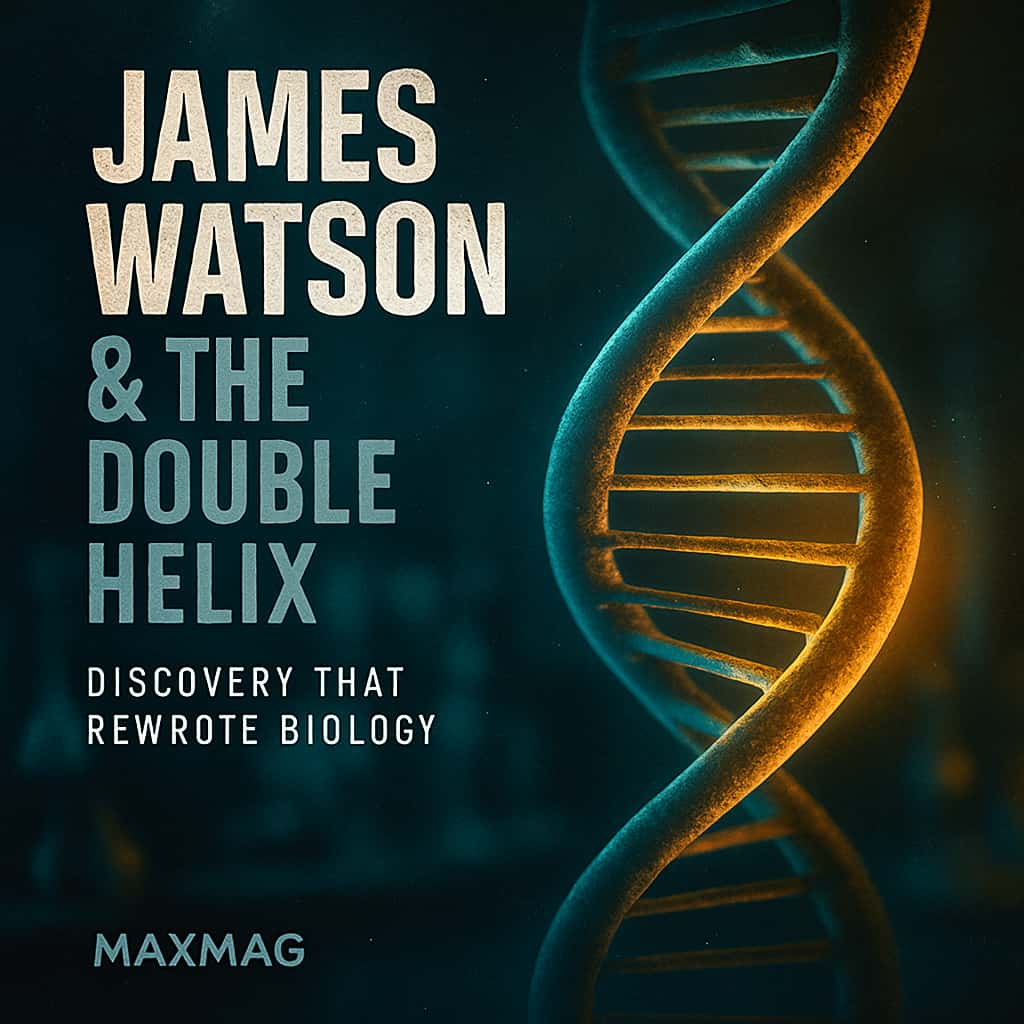
Key Works and Major Contributions of James Watson
From DNA structure to molecular biology pioneer
The double helix alone would have secured his place in any history of 20th century science. But the James Watson biography does not stop with that 1953 paper. In 1962, Watson, Crick and Wilkins shared the Nobel Prize in Physiology or Medicine, formally recognising their role in uncovering the molecular basis of heredity. Over the following decades, Watson helped establish molecular biology as a discipline, not just a discovery.
At Harvard University, where he joined the faculty in the mid-1950s, he supervised young researchers and shifted his experimental focus to RNA and viruses. He was not a methodical bench scientist in the traditional sense; instead, he excelled at spotting promising problems and pushing students and colleagues towards them. His lab contributed to understanding messenger RNA, the molecule that carries genetic instructions from DNA to the cell’s protein-making machinery, and to the study of small tumour viruses.
Textbooks that shaped generations
Watson’s textbooks may be his second most important contribution. Molecular Biology of the Gene, first published in the 1960s, and later Molecular Biology of the Cell, co-written with other leading scientists, turned the emerging field into a teachable subject. They blended clear diagrams, pointed summaries and bold, sometimes provocative commentary, helping to cement a shared language for molecular biologists around the world.
These books transformed how students encountered DNA, genes and cells, much as a single, influential textbook can shape how economics or philosophy is taught. For many undergraduates, their first encounter with the James Watson biography came not from a newspaper or television, but from the author photo on a front cover and the brisk, confident prose inside.
Institution-building and Cold Spring Harbor Laboratory
In 1968 Watson became director of Cold Spring Harbor Laboratory (CSHL) on Long Island, a small but historically important biology institute. Under his leadership, CSHL reinvented itself as a centre for molecular genetics, cancer research and advanced training. Summer courses and symposia there became legendary; to attend was to enter the inner circle of a fast-moving field.
Watson raised money aggressively, recruited young talent and pushed the institution to embrace the most modern techniques, from recombinant DNA to genomics. In doing so, he helped embed molecular thinking across many areas of biology, from plant genetics to neuroscience. This institutional role is a quieter part of the James Watson biography, but without it, the infrastructure of late 20th century molecular biology would have looked very different.
Methods, Collaborations and Working Style
Argument as a research method
Watson’s working style was famously combative. He preferred argument over politeness, speculation over caution, and big questions over small technical improvements. Colleagues often described him pacing corridors, quizzing students or tossing out outrageous suggestions to see who would push back. This style helped in the race to the double helix but made him a difficult collaborator in quieter times.
He believed that science advanced fastest when people were pushed – intellectually and emotionally – to outdo one another. For some, this made him an inspiring figure; for others, exhausting or intimidating. These dynamics are impossible to separate from the James Watson biography because they shaped everything from the tone of his books to the atmosphere in the institutions he led.
Partnerships: Watson and Crick, and beyond
The partnership with Francis Crick remains his most famous collaboration. Crick brought mathematical and physical intuition, Watson brought a nose for key biological problems and a willingness to challenge authority. Together they embodied a new kind of molecular biology pioneer, comfortable moving between disciplines and unafraid of stepping on toes.
Later in his career, Watson’s collaborations shifted towards administration, policy and large-scale projects. As one of the early leaders in the Human Genome Project, he argued for public funding to map all human genes, framing it as both a scientific imperative and a tool for medical progress. He also insisted on public access to the resulting data, fearing that private companies would monopolise the human genetic blueprint.
Controversies, Criticism and Misconceptions
Sexism, Rosalind Franklin and the story of the double helix
One of the most persistent critiques in any recent James Watson biography concerns his treatment of Rosalind Franklin. In his memoir The Double Helix, Watson portrayed her in dismissive, often sexist terms, referring to her appearance and temperament more than her scientific skill. The book helped cement a distorted public image of Franklin that historians and colleagues have spent decades correcting.
Today, accounts of DNA’s discovery place much greater emphasis on Franklin’s X-ray crystallography work and on the fact that key data were used without her explicit permission. The James Watson biography is therefore also a cautionary tale about credit, power and gender in science: who shapes the narrative of discovery, and whose contributions can be edited out.
Racist remarks and loss of honours
The most severe damage to Watson’s reputation came from his repeated racist statements about intelligence and populations of African descent, as well as other discriminatory comments about women and minorities. These views, aired in interviews and documentaries long after his major scientific work was done, prompted widespread condemnation from scientists and the public alike.
In 2019, Cold Spring Harbor Laboratory formally cut ties with Watson and stripped him of honorary titles, declaring his views “reprehensible” and “unsupported by science”. The decision was a turning point: an institution he had helped build publicly rejected him, underlining that scientific achievement does not grant immunity from moral responsibility. For a more journalistic overview of this fall from grace and the wider debates it triggered, readers can consult an in-depth Time magazine obituary of James Watson.
This rupture means that any honest James Watson biography must grapple with both sides: the visionary molecular biologist and the promoter of pseudoscientific racism. It is not a comfortable combination, but it reflects a broader reckoning within science about how to honour discoveries without endorsing all of the discoverer’s beliefs.
Misconceptions about the “lone genius”
Another misconception, encouraged in part by Watson’s own storytelling, is that breakthroughs like the DNA double helix are the work of isolated geniuses. In reality, as modern histories of molecular genetics emphasise, they emerge from networks of labs, rivalries and shared tools. Franklin, Wilkins, Luria, Linus Pauling and many others loom large in the background of any accurate James Watson biography.
Recognising this does not erase the creativity of Watson and Crick, but it shifts the narrative from one of individual heroics to one of collective endeavour. It also helps explain why the ethics of data sharing, collaboration and credit are such live issues in contemporary genomics.
Impact on Molecular Biology and on Wider Society
From double helix to medical revolution
The practical consequences of the work at the heart of the James Watson biography are vast. The double helix model made it possible to understand mutations, genetic diseases and the mechanisms by which viruses hijack cells. Over time, this knowledge led to genetic tests for inherited conditions, targeted cancer therapies and the prospect of gene editing tools like CRISPR.
Beyond medicine, DNA structure underpins forensic science, enabling investigators to match traces of blood or hair to individuals, and the booming ancestry-testing industry that promises to reconstruct family histories from cheek swabs. None of these applications would exist without the conceptual framework outlined in that 1953 paper and expanded by the molecular biology pioneers who followed.
Cultural symbol and ethical debates
DNA has also become a cultural symbol: a spiral on T-shirts, a logo for everything from biotech companies to science museums. The double helix stands for “life” itself in 21st century imagination. That symbolism, rooted in the events of the James Watson biography, has shaped how the public thinks about identity, fate and the limits of choice.
At the same time, genomics raises difficult ethical questions: Who owns genetic data? How should it be used in insurance, employment or policing? Watson sometimes spoke about these issues, but his own flawed views on race and intelligence also showed how easily genetics can be misused to justify prejudice. Modern bioethics arose partly in response to such dangers, insisting that the power unlocked by molecular biology must be guided by robust social and moral frameworks.

Personal Beliefs, Character and Private Life
Ambition, impatience and “Honest Jim”
Watson cultivated a reputation for bluntness. Friends and critics alike described him as sharp, funny, sometimes cruel, impatient with mediocrity and obsessed with being at the centre of events. His own memoir, subtitled “A Personal Account of the Discovery of the Structure of DNA”, presented him as “Honest Jim”: a narrator unafraid to reveal petty rivalries, social awkwardness and unflattering thoughts.
That candour made for gripping reading but also opened him to accusations of arrogance and insensitivity. The same personality traits that helped him cut through scientific hierarchy – challenging senior figures, mocking bad ideas – could, when turned on colleagues and entire communities, cause deep harm.
Family life and motivations
Away from the lab, Watson married Elizabeth Lewis in 1968, and they had two sons. One of them, Rufus, lives with schizophrenia, a fact Watson has spoken about publicly. According to several accounts, his concern for understanding mental illness partly fuelled his enthusiasm for the Human Genome Project and for research into the genetic underpinnings of complex conditions.
This mixture of personal vulnerability and public harshness is a recurring theme in the James Watson biography. Here was a man who could be deeply moved by his son’s struggles yet willing to make sweeping, damaging generalisations about entire groups of people. Reconciling those aspects is difficult – perhaps impossible – but they help explain why his story feels so unsettled.
Later Years and Final Chapter of James Watson
From celebrated elder to scientific outcast
Through the 1980s and 1990s, Watson was feted as one of the living founders of molecular biology. He received major honours, including the US Presidential Medal of Freedom and the National Medal of Science, and enjoyed a global platform as a commentator on science policy. For a time, the James Watson biography looked like a classic tale of upward trajectory: early brilliance, mid-career leadership, late-life recognition.
But as his controversial remarks accumulated – about race, gender, weight, sexual orientation – invitations dried up. His own colleagues distanced themselves. The stripping of honours by Cold Spring Harbor Laboratory, and his decision in 2014 to sell his Nobel Prize medal, were widely read as signs of a fall from grace.
Death and reassessment
James Watson died in November 2025 at the age of 97 in New York State, after a brief period in hospice care. Obituaries in scientific journals and major newspapers alike described him as both “one of the most influential – and controversial – scientists of the twentieth century” and as a figure whose views had become unacceptable in modern public life.
In the months and years following his death, assessments of the James Watson biography have grown more nuanced. Some emphasise that the DNA double helix would likely have been discovered soon by others; others argue that his relentless drive accelerated molecular biology by crucial years. Many agree on one point: any celebration of his scientific genius must go hand in hand with a clear rejection of his prejudiced beliefs.
The Lasting Legacy of James Watson biography
Science, story and the James Watson biography
The lasting legacy of the James Watson biography lies at the intersection of science and story. On one level, his life marks the moment when biology became a molecular science, when genes turned from abstract units into physical molecules that could be sequenced, edited and recombined. On another level, his career illustrates how the stories scientists tell – about themselves, their colleagues and entire populations – can reinforce or challenge existing power structures.
Today, students encounter Watson’s name alongside Rosalind Franklin’s in discussions about fairness and sexism; they meet his scientific achievements in textbooks and his prejudices in ethics seminars. Understanding this James Watson biography therefore helps us understand something larger about modern science: its capacity for breathtaking insight and its vulnerability to the biases of those who practise it.
If the double helix symbolises the shared genetic heritage of humanity, then the debates around James Watson biography remind us that how we use that knowledge – to heal or to divide, to explain or to stereotype – remains a choice. His life’s work made those choices inescapably clear. Our generation, and those that follow, will continue to live with the consequences.
Frequently Asked Questions about James Watson biography
Q1: Who was James Watson and why is he important in modern genetics?
Q2: What did James Watson, Francis Crick and their colleagues actually discover about DNA?
Q3: How did Rosalind Franklin contribute to the discoveries in the James Watson biography?
Q4: Why is James Watson such a controversial figure today?
Q5: What role did James Watson play in the Human Genome Project?
Q6: How should we think about the legacy described in this James Watson biography?



